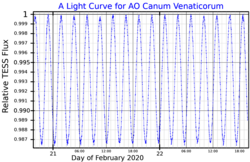20 Canum Venaticorum
| Observation data Epoch J2000 Equinox J2000 | |
|---|---|
| Constellation | Canes Venatici |
| Right ascension | 13h 17m 32.54093s[2] |
| Declination | +40° 34′ 21.3875″[2] |
| Apparent magnitude (V) | +4.715[3] |
| Characteristics | |
| Spectral type | A9 II mF2[4] |
| B−V color index | 0.30[3] |
| Variable type | δ Sct[5] |
| Astrometry | |
| Radial velocity (Rv) | 9.32±0.16[6] km/s |
| Proper motion (μ) | RA: −113.761[2] mas/yr Dec.: +19.858[2] mas/yr |
| Parallax (π) | 13.7210 ± 0.1581 mas[2] |
| Distance | 238 ± 3 ly (72.9 ± 0.8 pc) |
| Details | |
| Mass | 2.43[3] M☉ |
| Radius | 4[7] R☉ |
| Luminosity | 63[3] L☉ |
| Surface gravity (log g) | 2.97[8] cgs |
| Temperature | 7,314±42[3] K |
| Metallicity [Fe/H] | 0.18[7] dex |
| Rotational velocity (v sin i) | 15[9] km/s |
| Age | 750[3] Myr |
| Other designations | |
| Database references | |
| SIMBAD | data |
20 Canum Venaticorum is a single[11] variable star in the northern constellation of Canes Venatici, located 238 light years from the Sun. This object has the variable star designation AO Canum Venaticorum; 20 Canum Venaticorum is the Flamsteed designation. It is visible to the naked eye as a faint, white-hued star with a baseline apparent visual magnitude of +4.72.[3] The star is moving further from the Earth with a heliocentric radial velocity of +9 km/s.[6] Eggen (1971) listed this star as a member of the Hyades Stream.[12]
This star has a stellar classification of A9 II mF2, which indicates the hydrogen line matches an A-type bright giant but the metal lines are closer to an F-type star. However, it does not appear to be an Am star as the Calcium K line is normal.[4] Earlier, Morgan and Abt (1972) assigned it a giant star class of F3 III.[13] William Henry Wehlau et al. announced that the star's brightness varies, in 1966.[14] It is classified as a Delta Scuti type variable star with a single radial pulsation mode providing the best fit to the observed variation.[5] Its brightness varies from magnitude +4.70 to +4.75 with a period of 2.92 hours.[15]
20 Canum Venaticorum is 750[3] million years old with 2.43[3] times the mass of the Sun and 4[7] time the Sun's radius. It is radiating 63[3] times the Sun's luminosity from its photosphere at an effective temperature of 7,314 K.[3]
References
- ^ "MAST: Barbara A. Mikulski Archive for Space Telescopes". Space Telescope Science Institute. Retrieved 8 December 2021.
- ^ a b c d e van Leeuwen, F. (2007), "Validation of the new Hipparcos reduction", Astronomy and Astrophysics, 474 (2): 653–664, arXiv:0708.1752, Bibcode:2007A&A...474..653V, doi:10.1051/0004-6361:20078357, S2CID 18759600.
- ^ a b c d e f g h i j k Luck, R. Earle (2015), "Abundances in the Local Region. I. G and K Giants", Astronomical Journal, 150 (3), 88, arXiv:1507.01466, Bibcode:2015AJ....150...88L, doi:10.1088/0004-6256/150/3/88, S2CID 118505114.
- ^ a b Gray, R. O.; et al. (2001), "The Physical Basis of Luminosity Classification in the Late A-, F-, and Early G-Type Stars. I. Precise Spectral Types for 372 Stars", The Astronomical Journal, 121 (4): 2148, Bibcode:2001AJ....121.2148G, doi:10.1086/319956.
- ^ a b Chadid, M.; et al. (August 2001), "20 CVn: A monoperiodic radially pulsating delta Scuti star", Astronomy and Astrophysics, 375: 113–121, Bibcode:2001A&A...375..113C, doi:10.1051/0004-6361:20010809.
- ^ a b Brown, A. G. A.; et al. (Gaia collaboration) (August 2018). "Gaia Data Release 2: Summary of the contents and survey properties". Astronomy & Astrophysics. 616. A1. arXiv:1804.09365. Bibcode:2018A&A...616A...1G. doi:10.1051/0004-6361/201833051. Gaia DR2 record for this source at VizieR.
- ^ a b c Massarotti, Alessandro; et al. (January 2008), "Rotational and Radial Velocities for a Sample of 761 HIPPARCOS Giants and the Role of Binarity", The Astronomical Journal, 135 (1): 209–231, Bibcode:2008AJ....135..209M, doi:10.1088/0004-6256/135/1/209.
- ^ Adamczak, Jens; Lambert, David L. (August 2014), "Carbon and Oxygen Abundances across the Hertzsprung Gap", The Astrophysical Journal, 791 (1): 12, arXiv:1407.2157, Bibcode:2014ApJ...791...58A, doi:10.1088/0004-637X/791/1/58, S2CID 119104634, 58.
- ^ Royer, F.; et al. (October 2002), "Rotational velocities of A-type stars in the northern hemisphere. II. Measurement of v sin i", Astronomy and Astrophysics, 393: 897–911, arXiv:astro-ph/0205255, Bibcode:2002A&A...393..897R, doi:10.1051/0004-6361:20020943, S2CID 14070763.
- ^ "20 CVn". SIMBAD. Centre de données astronomiques de Strasbourg. Retrieved 2018-07-26.
- ^ Eggleton, P. P.; Tokovinin, A. A. (2008), "A catalogue of multiplicity among bright stellar systems", Monthly Notices of the Royal Astronomical Society, 389 (2): 869–879, arXiv:0806.2878, Bibcode:2008MNRAS.389..869E, doi:10.1111/j.1365-2966.2008.13596.x, S2CID 14878976.
- ^ Eggen, O. J. (December 1971), "Luminosities and Motions of the F-Type Stars. I. Luminosity and Metal Abundance Indices for Disk Population Stars", Publications of the Astronomical Society of the Pacific, 83 (496): 741, Bibcode:1971PASP...83..741E, doi:10.1086/129211, S2CID 119993774.
- ^ Morgan, W. W.; Abt, H. A. (February 1972), "The spectral classification of the F stars of intermediate luminosity", Astronomical Journal, 77: 35–37, Bibcode:1972AJ.....77...35M, doi:10.1086/111242.
- ^ Wehlau, W. H.; Chen, S. C. N.; Symonds, G. (July 1966). "Light Variability of 20 Canum Venaticorum". Information Bulletin on Variable Stars. 143: 1–2. Bibcode:1966IBVS..143....1W. Retrieved 6 January 2025.
- ^ Samus, N. N.; et al. (2017), "General Catalogue of Variable Stars", Astronomy Reports, 5.1, 61 (1): 80–88, Bibcode:2017ARep...61...80S, doi:10.1134/s1063772917010085, S2CID 125853869.

